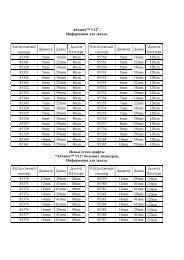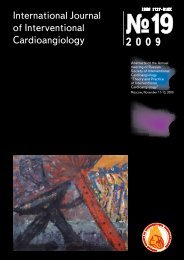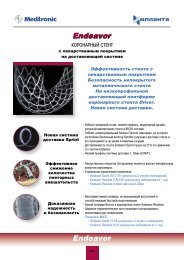Results of Coronary Stenting using the Stents with
Results of Coronary Stenting using the Stents with
Results of Coronary Stenting using the Stents with
You also want an ePaper? Increase the reach of your titles
YUMPU automatically turns print PDFs into web optimized ePapers that Google loves.
Interventional angiology<br />
Fig. 1 Fig. 2<br />
giography <strong>the</strong> false aneurysm did not opacify, <strong>the</strong><br />
blood flow in <strong>the</strong> stented segment was preserved,<br />
<strong>the</strong>re was an over 50% stenosis in <strong>the</strong> initial segment<br />
<strong>of</strong> <strong>the</strong> implanted stent. Balloon dilatation <strong>of</strong> this segment<br />
was performed <strong>with</strong> <strong>the</strong> use <strong>of</strong> AgilTrac balloon<br />
(Guidant) 6.0 x 40.0 mm.<br />
Control angjography revealed a stented segment<br />
<strong>with</strong> regular contours, <strong>with</strong>out residual stenosis. The<br />
aneurysm was not opacified (fig2).<br />
Control duplex scanning in <strong>the</strong> projection <strong>of</strong> <strong>the</strong><br />
2nd segment <strong>of</strong> <strong>the</strong> RSA revealed a heterogenous<br />
roundish mass measuring 60 x 40 mm, <strong>with</strong> intraluminal<br />
parietal thrombosis, located at <strong>the</strong> anterolateral<br />
wall. Turbulent blood flow was not seen. The<br />
stent-graft was patent, <strong>the</strong> magistral blood flow was<br />
preserved.<br />
Postoperative condition <strong>of</strong> <strong>the</strong> patient was satisfactory.<br />
He had no complaints. The symptoms<br />
<strong>of</strong> compression neuritis <strong>of</strong> <strong>the</strong> brachial plexus regressed.<br />
In 7 days after endovascular intervention<br />
<strong>the</strong> patient was discharged under <strong>the</strong> care <strong>of</strong> a local<br />
physician.<br />
Discussion<br />
The lesions <strong>of</strong> <strong>the</strong> subclavian artery can be<br />
caused by penetrating injury by <strong>the</strong> fragments <strong>of</strong><br />
fractured clavicle, <strong>the</strong> displacement <strong>of</strong> metal elements<br />
<strong>of</strong> constructions used for os<strong>the</strong>osyn<strong>the</strong>sis<br />
(6, 7, 9, 10, 12). Pares<strong>the</strong>sia and paresis <strong>of</strong> <strong>the</strong> arm<br />
are typical symptoms <strong>of</strong> brachial plexus compression<br />
(6, 9, 12). As a rule, <strong>the</strong> time interval between<br />
<strong>the</strong> primary trauma and <strong>the</strong> diagnosis <strong>of</strong> a false<br />
aneurysm is long. Skeletal and muscular lesions<br />
as well as <strong>the</strong> gradual growth <strong>of</strong> <strong>the</strong> aneurismal<br />
cavity hamper timely diagnostics and treatment<br />
<strong>of</strong> this condition. Severe neurological abnormalities,<br />
related to <strong>the</strong> compression <strong>of</strong> brachial plexus,<br />
compression embolism <strong>of</strong> <strong>the</strong> subclavian vessels,<br />
as well as <strong>the</strong> rupture <strong>of</strong> false aneurysm <strong>with</strong> <strong>the</strong><br />
development <strong>of</strong> arterial bleeding, are severe, lifethreatening<br />
complications.<br />
Open surgical approach in various segments <strong>of</strong><br />
<strong>the</strong> subclavian artery is associated <strong>with</strong> sternotomy<br />
or <strong>the</strong> resection <strong>of</strong> a fragment <strong>of</strong> clavicle <strong>with</strong> subsequent<br />
os<strong>the</strong>osyn<strong>the</strong>sis, is ra<strong>the</strong>r traumatic and<br />
elongates <strong>the</strong> rehabilitation period. The risk <strong>of</strong> wound<br />
infection and massive blood loss is always higher <strong>with</strong><br />
open surgery (3, 5, 7, 10, 12).<br />
Endovascular treatment is minimally traumatic,<br />
minimizes <strong>the</strong> blood loss and <strong>the</strong> probability <strong>of</strong> infection.<br />
The rehabilitation period after intravascular intervention<br />
is enormously shorter in comparison <strong>with</strong><br />
open surgery.<br />
There are few reports <strong>of</strong> such cases in world literature<br />
(1, 2). However we did not find any description<br />
<strong>of</strong> endovascular correction <strong>of</strong> a post-injection false<br />
aneurysm <strong>with</strong> <strong>the</strong> use <strong>of</strong> a stent-graft.<br />
Conclusion<br />
Due to currently available materials and technologies,<br />
<strong>the</strong> method <strong>of</strong> endovascular separation <strong>of</strong> <strong>the</strong><br />
false aneurismal cavity from <strong>the</strong> true arterial lumen<br />
allows to obtain good results in <strong>the</strong> correction <strong>of</strong> vascular<br />
wall lesions.<br />
Minimal invasiveness, high effectiveness, absence<br />
<strong>of</strong> blood loss allow to consider <strong>the</strong> endovascular<br />
method as one <strong>of</strong> <strong>the</strong> leading modalities <strong>of</strong> treatment<br />
<strong>of</strong> false aneurysms <strong>of</strong> different genesis.<br />
References<br />
1. Babatasi G., Massetti M., Le Page O. Endovascular<br />
treatment <strong>of</strong> a traumatic subclavian artery<br />
aneurysm. J. Trauma, 1998, 44, 545-7.<br />
2. Becker G., Benenati J., Zemel G. Percutaneous<br />
placement <strong>of</strong> a balloon-expandable intraluminal<br />
graft for life-threatening subclavian arterial haemorrhage.<br />
JVIR, 1991, 2, 225-9.<br />
3. Jeganathan R., Harkin D., Lowry P. Iatrogenic<br />
subclavian artery pseudo-aneurysm ca<strong>using</strong> airway<br />
compromise : treatment <strong>with</strong> percutaneous thrombin<br />
injection. J. Vasc. Surg., 2004, 40, 371-4.<br />
40<br />
(№ 26, 2011)
















